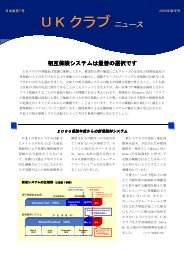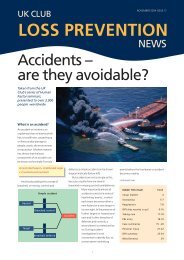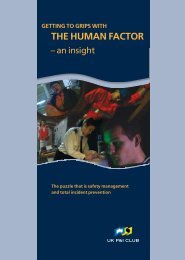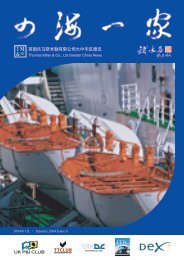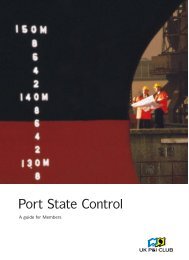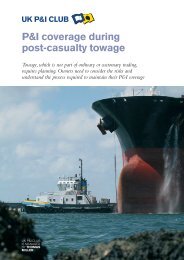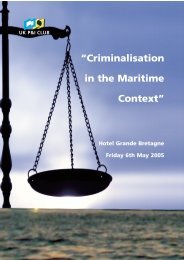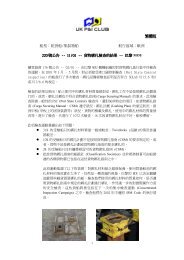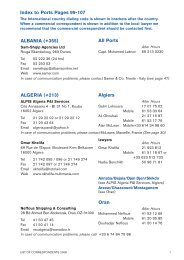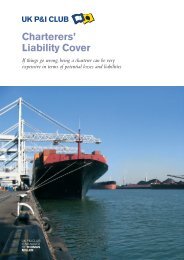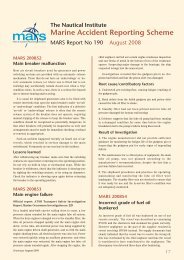Read full text
Read full text
Read full text
- No tags were found...
Create successful ePaper yourself
Turn your PDF publications into a flip-book with our unique Google optimized e-Paper software.
major tanker fleets - Novorossiysk, Latvian, Georgian and Primorsk Shipping Companies - were entered in theclub by way of a reinsurance of Ingosstrakh, the state insurance organisation. Acting largely on their own initiative,from the mid-1960s a number of Eastern Bloc countries, notably Bulgaria, East Germany, Estonia andRomania came into the club.The entry of the other great Communist power, China, is a similar, later story, starting in 1973. Chinese shipsat the time were either uninsured or had a limited cover from the People’s Insurance Company of China inBeijing. As a consequence shipping companies were finding that they had not got the insurance necessary tocover their TOVALOP pollution liabilities. They were not able to charter their ships to oil companies, whowould demand insurance against TOVALOP liabilities and so in 1973 the People’s Insurance Company inviteddelegates from the UK Club managers to meet them in Beijing to see whether the entry of certain tankers couldbe negotiated.Terence Coghlin was one of the delegates: I set out with Sidney Fowler and with William Richards, an averageadjuster who had been to Beijing before. Our train from Hong Kong stopped at the border river. After we had crossed overthe bridge into the People’s Republic, we were given a deliberately chilling reception by the Chinese border guards. Our passportswere taken away and we were left to cool our heels for some considerable time, without explanation, in an unfurnishedbarrack like building. Upon our release we at once experienced the contrast between official and private China. We werewarmly greeted by three charming people from the local branch if the People’s Insurance Company (PICC). Over the nextfew days they showed us Guangzhou. We visited schools and factories and stood ankle deep in a collective farm’s paddyfield, helping to harvest rice. Everywhere we went we were lectured about the wicked way of the West in general and theAmericans in particular and assured that Chairman Mao’s thoughts would conquer the world. We sat quietly and held ourlittle red books reverently. On page 233 of the little red book, Quotations from Chairman Mao Tse Tung, there wasample justification for the whole exercise in an extract from Oppose Book Worship (1930): You can’t solve a problem?Well, get down and investigate the present facts and its past history! When you have investigated the problem thoroughly,you will know how to solve it. Conclusions invariably come after investigation, and not before. Only a blockheadcudgels his brains on his own, or together with a group, to ‘find a solution’ or ‘evolve an idea’ without making any investigation.It must be stressed that this cannot possibly lead to any effective solution or any good idea.Terence Coghlin continues: Thus initiated we were allowed to travel on to Beijing and visit the head offices of boththe PICC and of China Ocean Shipping Company (COSCO). After further days of sightseeing - most notably the GreatWall and the adjacent Ming Tombs - our hosts at last felt it appropriate to mention business and we arranged the entrythrough PICC of several COSCO tankers. The Chinese were also quick to benefit, as Luke <strong>Read</strong>man records: Inthe first year of their entry, before any of the other branches had entered their ships, the Tianjin Branch had a total loss withthe Ying Shan caught in a typhoon of Japan. That produced a big wreck removal problem. So their record started with quitea substantial bang and it was indeed a pool claim by the time we had paid for the wreck removal and solved the variousother problems such as the cargo. That was certainly the most important claim that affected a Chinese shipowner for manyyears. The news if that would have spread within the Chinese shipping community. Of course it did affect the rate that weneeded for the renewal of that fleet and we started even at that stage the differentiation between the rates payable by differentbranch companies of COSCO. Each one from the earliest times has kept its individual record and its individual rate,depending on its own claims record.Over in Japan the history of P & I is older. In 1908 Professor S. Tasaki of Nagasaki High Commercial Collegereported on the subject after learning about it in London from the managers of the UK Club. Later he becamepresident of Kobe University and, under his guidance, the appropriate law was enacted and a Japanese P & I clubestablished in Kobe in 1950. At first, as part of the post-war reconstruction of Japan, Frank Ledwith and then




